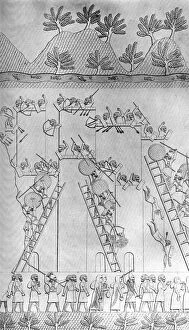Austen Henry Collection
Austen Henry Layard, a name synonymous with archaeological brilliance and historical preservation
All Professionally Made to Order for Quick Shipping
Austen Henry Layard, a name synonymous with archaeological brilliance and historical preservation. Born in 1817, this British archaeologist, politician, and diplomat left an indelible mark on the world of antiquities. Layard's passion for uncovering ancient civilizations led him to Nineveh, where he meticulously documented its monuments through his intricate drawings. His first series of sketches captured the essence of this once-great city, bringing it back to life for future generations. One notable drawing is "The Procession of the Bull" from 1890. Though its creator remains unknown, Layard's keen eye ensured that every detail was accurately depicted. Another masterpiece was "The Palace of Kouyunjik, " restored after Layard's work in 1853. This architectural marvel showcased the grandeur that once graced Assyria. Layard's dedication extended beyond mere drawings; he actively participated in excavations as well. One such endeavor involved restoring "The Palaces of Nimrud" in 1853. Through his meticulous efforts, these palaces were resurrected from ruins and brought back to their former glory. His expertise also shed light on historic events like "A City Taken by Assault by the Assyrians. " Created around c1900-1920 but depicting events from centuries earlier, this artwork vividly portrayed warfare during ancient times. Similarly captivating was his depiction of the "Assault on the City of Lachish, " showcasing Sir Austen Henry Layard's artistic prowess alongside his archaeological achievements. Not limited to documenting history alone, Layard played a significant role as a diplomat too. As British Ambassador to Constantinople in 1877, he represented his nation with honor and distinction – a testament to his multifaceted talents. Throughout his illustrious career spanning decades, Austen Henry Layard became renowned worldwide for unearthing forgotten treasures and preserving them for posterity.














